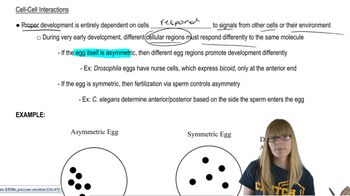In gain-of-function let-23 and let-60 C. elegans mutants, all of the vulval precursor cells differentiate with 1° or 2° fates. Do you expect adjacent cells to differentiate with 1° fates or with 2° fates? Explain.
Table of contents
- 1. Introduction to Genetics51m
- 2. Mendel's Laws of Inheritance3h 37m
- 3. Extensions to Mendelian Inheritance2h 41m
- 4. Genetic Mapping and Linkage2h 28m
- 5. Genetics of Bacteria and Viruses1h 21m
- 6. Chromosomal Variation1h 48m
- 7. DNA and Chromosome Structure56m
- 8. DNA Replication1h 10m
- 9. Mitosis and Meiosis1h 34m
- 10. Transcription1h 0m
- 11. Translation58m
- 12. Gene Regulation in Prokaryotes1h 19m
- 13. Gene Regulation in Eukaryotes44m
- 14. Genetic Control of Development44m
- 15. Genomes and Genomics1h 50m
- 16. Transposable Elements47m
- 17. Mutation, Repair, and Recombination1h 6m
- 18. Molecular Genetic Tools19m
- 19. Cancer Genetics29m
- 20. Quantitative Genetics1h 26m
- 21. Population Genetics50m
- 22. Evolutionary Genetics29m
14. Genetic Control of Development
Early Developmental Steps
Problem 16
Textbook Question
Formation of germ cells in Drosophila and many other embryos is dependent on their position in the embryo and their exposure to localized cytoplasmic determinants. Nuclei exposed to cytoplasm in the posterior end of Drosophila eggs (the pole plasm) form cells that develop into germ cells under the direction of maternally derived components. R. Amikura et al. [(2001). Proc. Nat. Acad. Sci. (USA) 98:9133–9138] consistently found mitochondria-type ribosomes outside mitochondria in the germ plasma of Drosophila embryos and postulated that they are intimately related to germ-cell specification. If you were studying this phenomenon, what would you want to know about the activity of these ribosomes?
 Verified step by step guidance
Verified step by step guidance1
Step 1: Understand the role of mitochondria-type ribosomes in germ-cell specification. Begin by reviewing the function of ribosomes in general and how they contribute to protein synthesis. Specifically, investigate how mitochondria-type ribosomes differ from cytoplasmic ribosomes in terms of structure and function.
Step 2: Formulate a hypothesis about the activity of mitochondria-type ribosomes in the germ plasma. For example, hypothesize whether these ribosomes are synthesizing specific proteins that are critical for germ-cell specification or interacting with localized cytoplasmic determinants.
Step 3: Design experiments to test the activity of these ribosomes. Consider using techniques such as ribosome profiling to identify the mRNA sequences being translated by these ribosomes. This will help determine whether they are producing proteins unique to germ-cell development.
Step 4: Investigate the localization and interaction of mitochondria-type ribosomes with other components in the pole plasm. Use imaging techniques like fluorescence microscopy or electron microscopy to visualize their spatial distribution and potential interactions with maternally derived components.
Step 5: Analyze the results to determine whether the activity of mitochondria-type ribosomes is directly linked to germ-cell specification. Compare the protein synthesis profiles of these ribosomes in germ plasma versus other regions of the embryo to identify any unique patterns or functions.
 Verified video answer for a similar problem:
Verified video answer for a similar problem:This video solution was recommended by our tutors as helpful for the problem above
Video duration:
1mPlay a video:
Was this helpful?
Key Concepts
Here are the essential concepts you must grasp in order to answer the question correctly.
Germ Cell Formation
Germ cell formation is the process by which specialized cells, destined to become gametes (sperm and eggs), are generated from embryonic cells. In Drosophila, this process is influenced by the spatial arrangement of cells and the presence of cytoplasmic determinants, which are molecules that regulate gene expression and cell fate based on their location within the embryo.
Recommended video:
Guided course

Cell-cell interactions
Cytoplasmic Determinants
Cytoplasmic determinants are substances found in the cytoplasm of a fertilized egg that influence the development of the embryo by determining the fate of cells. In Drosophila, these determinants are localized in specific regions, such as the posterior end, and play a crucial role in specifying which cells will become germ cells, guiding their development through maternal factors.
Recommended video:
Guided course

Sex Determination
Mitochondrial Ribosomes
Mitochondrial ribosomes are specialized ribosomes found within mitochondria, responsible for synthesizing proteins essential for mitochondrial function. The presence of these ribosomes outside mitochondria in the germ plasma of Drosophila suggests a unique role in germ cell specification, potentially indicating that they contribute to the translation of proteins necessary for the development and maintenance of germ cells.
Recommended video:
Guided course

Ribosome Structure

 3:46m
3:46mWatch next
Master Drosophilia Development with a bite sized video explanation from Kylia
Start learningRelated Videos
Related Practice
Textbook Question
369
views
